An Example in Toshima City
I have to say that circumstance of riding bicycle in Japanese cities is not good. For example there are no buses with rack for bicycle, and no subway allow to carry into your bicycle in Japan. Not only in comparison with the case in Europe and America but also as a guide point of discernment urban dweller and kindness to every urban dweller and environment. I will submit to you an example which would be worse case in 23 cities of Tokyo Metropolis besides all over Japan.
How Was Made "Hochi-jitensha"?
Notion & Definition
According to statistics, around the east exit of Ikebukuro station there are most "hochi-jitensha" in Japan. We should have some questions. One is how much area does "around" mean. And the one is what does the word "hochi-jitensha" mean. In Japanese language "jitensha" is bicycle and "hochi" means to leave behind or let as it is. But "hochi-jitensha" is not as such. Needless to say there are few bicycles on the road left like a trash! The answer to the 1st question is that it means the area where local law bans to park bicycle. Local law itself is made by local diet. But the area of application is designed through administrative procedure without local diet. The answer to the 2nd question is that it means the bicycle in the banned area and not in the parking established by local government. So we have to reconfirm that "hochi-jitensha" is a political notion depend on local officials.
If we began to discuss about "hochi-jitensha" without analysing the notion, we will exhaust each other, but make ourselves blind to the essence of the problem. I dare say there are many things like this in our circumstances -- to be analysed with special consciousness. Starting with the case, let's regain wholesome, critical and independent spirit. (Please reference with "Situation of Bicycle in Japanese Cities").
Unable to & Won't to Disappear
Basically administrative authority's counter measuring policy against "hochi-jitensha" is in relation with the chance to make constructional concession. The more expensive the authority construct, the more expensive need to maintain and management, and never stop the way. As a result we, especially bicycle
rider, have to pay such a foolish fee. It is a serious problem.
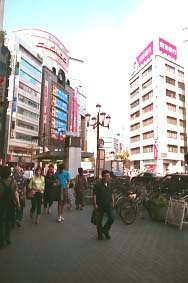
Parked bicycle in front of East Exit of Ikebukuro station (2000.9.9)
Ikebukuro is in the midst of Toshima City and central core of business and shopping and so on. It was Saturday afternoon when shopper was been increasing. Generally at the place enough to park bicycle, most of local government allow to park without fee, in some case providing roof. Though it is the cheapest way for local government and the most grateful way for bicycle rider, Toshima City government never does as such. If so, legalizing to park bicycle, "Hochi-jitensha" as victim will be disappear. Through the way "Hochi-jitensha" is raised.
Attitude of Mass Media (1)
Generally Japanese mass media are not so interested in bicycle that nearly none of them treat it as a mean of transportation in cities, have special concern in relation to environmental affairs, either. As a result they only to copy from authority to people via paper and wave. Such an attitude is not only to bicycle. So it is a serious problem.
There are no press or news on bicycle through as such in Europe and America. If so people will neglect to. Now we can access to media all over the world on the web, we Japanese are to realize.
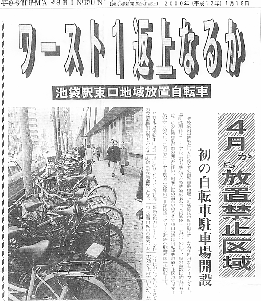 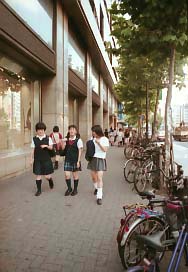
Local newspaper "Toshima shimbun" (2000.1.18)
Nearly same place in south of East Exit of Ikebukuro station (2000.9.9)
It reports on the side of authority that City authority reinforces to keep parked bicycle out with poor excuse to finish construction of parking, Both pictures were taken on the nearly same place, but attitudes to bicycle are in contrast apparently. Can you say the newspaper is not biased?
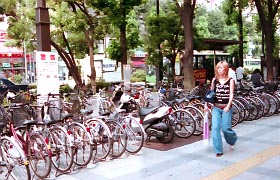 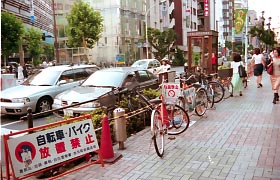
East side of Ikebukuro station (2001.7.9)
In the rainy season when the bicycle user decreases temporarily because of rain, Toshima City authority strengthened hatred policy to the bicycle. It requires more expensive fee raised to 3000 yen for return of the bicycle moved away under the name of""hochi-jitensha" so it strengthened exploitation from the bicycle user. Also, it put an obstacle, investing a tax. In addition to make pavement narrow by the obstacle. The city authority intend to impress hatred feelings to the bicycle. If servicing this part as the bicycle parking, needless to say, it becomes the profit for both of the pedestrian and the bicycle, too.
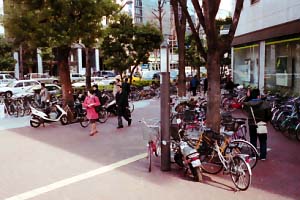
Green Avenue(2002.2.7)
The road which extends from Ikebukuro station to Gokokuji has been called Hinode Avenue, but, nowadays between Ikebukuro and East Ikebukuro is called Green Avenue. October of 2001, Toshima City authority forced to designate the pavement of the avenue as the bicycle parking which needs annual contract system, and expand the area which made parking bicycle illeagalized. The management members glaring the pedestrian are arranged at several dozen meter intervals attendant on the pavement, As for this space, being utilized where close to Ikebukuro station only, there are no user almost of the north side and the south side close to East Ikebukuro. It is the result of ignoring utilization needs. On the closest area to Ikebukuro station, main duty of the management member is to exclude the bicycle user other than the register person from the space. So that more bicycle users are no choice but to park their bicycles other than the driveway along where no bicycles parked until recently.
Hatred Policy to the Bicycle by Toshima City Authority
Needless to say constructed things is effected to consciousness and thought of the side of planning and managing. We will examine consciousness and thought of Toshima City authority reflected on the public institutes Examples as bellows are worse ones but are not special ones.
The section treating bicycle is different among local governments. In Toshima City bicycle have been controlled by counter measuring section to traffic problems -- changed the name to section of traffic safety in April 2000 -- in construction division. Regardless of changing name hatred policy to bicycle by Toshima City authority is strengthened. It is not going too far to say that the policy in fact is basically in common with witch hunting in Medieval Europe, extermination policy to Jews by Nazis and ethnic cleansing in ex-Yugoslavia I have an apprehension that you understand it as go too far, but that is not correct but contrary. These consciousness and thought are in us, too. Please analyse why "hochi-jitensha" is felt as unpleasant.
In short because it is recognized as other thing different in quality. It is not recognized as an object to sympathize and identify. So it is recognized and treated as an object to replace and extant or to be made transform assimilate to "ourselves" unilaterally. With power and violence administrative and police authority take part. Authorities and "citizen" become in complicity.
As it goes forward ---- I think it is not needed to explain any more for clever readers. Needless to say policies and attitudes to bicycle by administrative authority must be changed. We Japanese citizen also must change ourselves from the viewpoint of being common with various urban dwellers and environment.
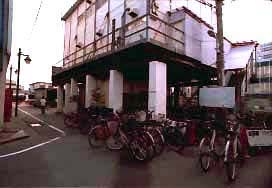 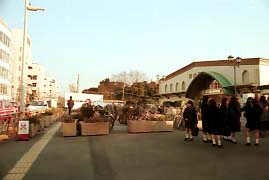
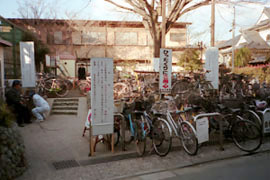
JR Mejiro station(2000.9.9, 2001.2.20 & 2002.2.12)
For the spanning replacement of the over bridge of Mejiro street passing in front of the station and reconstruct a station building, the landscape is changing but the situation concerning the bicycle is indeed tracing the only way of the aggravation. The left pic. is the bicycle parking which was in the east side of the station from before. A construction office is constructed on it and the police box is next to it But it was formed to conceal a bicycle from the station and the street. So it becomes difficult to touch course and a notice. The conservator who was sent to this place from the city authority arranged a bicycle but they handle a bicycle disorderly and reach even criminal act such as the damaging and so on. So it is the worst bicycle parking place in the city. The reconstruction of the station building was finished in the winter in 2000, so people park their bicycles in front of the station. Because of the remainder budget digestion at the end of the budget year which is peculiar to the government office, the city authority put a flower planter and so on in the form which imposes restrictions on bicycle parking . Furthermore the city authority will enforce to construct the charged bicycle parking and make illegal parking bicycle around the station. So, these bicycle parkings (free of charge) will be abolished.
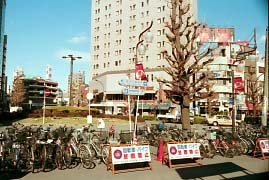
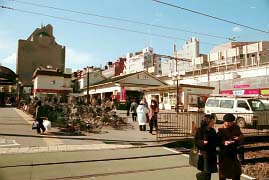
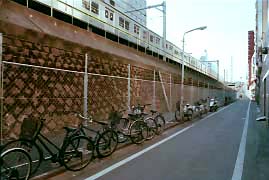
JR Otsuka station(2001.3.2)
1994-5, the suppression to parking bicycle in front of the station was vigorous but now it seems eased. However, it isn't recovering to the situation before. There still is more bicycle parking space in front of the southern exit. (upper right). Bicycle parking is decreased at the northern exit because of construction of the buildings near the station (upper left), This vacant land near the track which had been used as bicycle parking space enclosed with the fence. there is a steep climbing slope and there is small bicycle parking space at the summit of it (under).
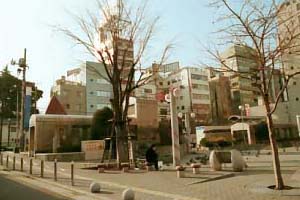 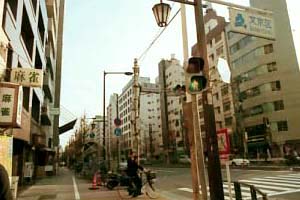
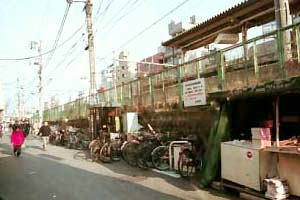
Around Komagome station(2002.2.7)
As for Komagome station, Namboku line of Eidan subway and the west entrance of JR Yamanote line at Toshima City (left pic.), the east entrance at Kita City (right pic.). Toshima City constructed the underground bicycle parking that costs most expensive costs of maintenance besides construction (without saying, this is shifted to the user!) and able to park fewer bicycles, and has left not utilized the above-ground part on that. So some bicycle users park their bicycles on the street nearby Rikugien garden at Bunkyo City (under pic.). At Kita City, on the othre hand, utilizing the space along the railroad track, bicycle parking is made without waste cost and become easy to utilize.
Please reference with "An Example in Kita City of Tokyo".
Erasing Bicycle from Urban Landscape
It is a goal for Toshima City Authority's policy to erase bicycle from Urban landscape. We can understand easily that almost all of bicycle parking of public institutions in Toshima City are constructed and managed as such. If city authority had judgement to prepare bicycle parking as demand or to spend budget effectively, they would never do such a foolish act. There are many examples here and there in Toshima City.
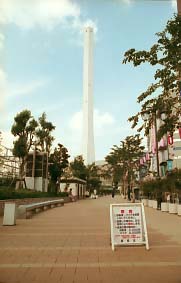
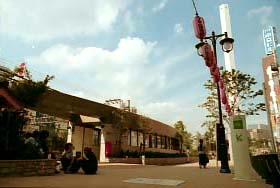
On the ground of underground bicycle parking near to East Exit of Ikebukuro station (2000.9.9)
Along with railway once there was a park here used as bicycle parking free of charge. But Toshima City government destroyed it and began to construct underground bicycle parking. With poor excuse to finish construction of new parking, city government reinforced to keep parked bicycle out, banned parking on the ground and forced to pay for parking as much expensive as subway. New parking is much smaller than old one, but cost so expensive. So I have to say that raison d'être of it is an effect to erasing bicycle from urban landscape. (I was refused to take photos inside.)
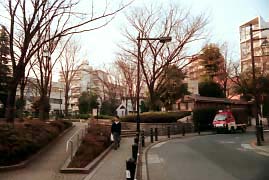
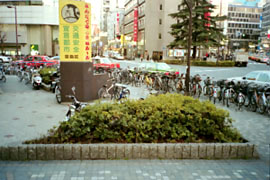
On the ground of underground bicycle parking near to West Exit of Ikebukuro station (2001.2.20),
West side of Ikebukuro Station (2002.2.12)
It is this that became a precedent of underground bicycle parking near to East Exit of Ikebukuro station . City authority constructed underground charged bicycle parking under the park where needs several mites' walk from west exit of Ikebukuro station. A mass media reported it was inconvenient and far from the station so there were only a few users. However, the essence of the problem is the hatred policy to the bicycle by authority such as the pursuing of constructional concession, the erasing of the bicycle from urban landscape, exploitation from people.
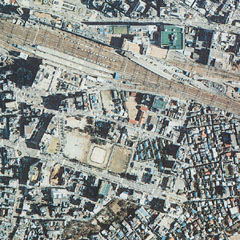 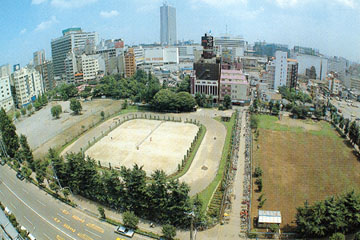
Around Ikebukuro about 20 years ago
The place where now Tokyo Thatre of Art, has had the land of the large area, because it is utilized as the school and the ground. We can understand that the bicycle was excluded and constructed the buildings with the special cost which turns the bill to the citizen through the process of re-development, It is clear that bicycle were able to be parked (at least between the grounds) more than now able to in the bicycle parking place "nearby" Ikebukuro station west entrance.
From "The 50 years of Toshima City from the photograph" (October of 1982)
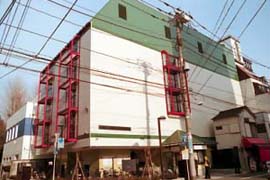 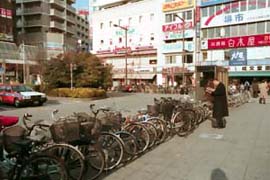
North side of Sugamo station (2002.2.7)
Around Sugamo station was illegalized bicycle parking Just 1 year after Ikebukuro station east entrance. The bicycle parking place was constructed with ecessive cost -- turns the bill to the user -- where far from the station of both JR and Metropolitan subway and difficult to find.
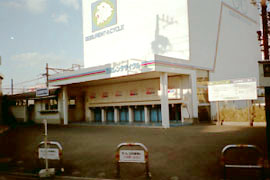 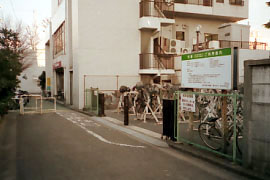
Bicycle parkings nearby Higashi-Nagasaki (left) & Shiinamachi (right) (2002.2.12)
These are managed by Seibu Railway Company. The fee is more expensive than public one. It is an example that managing bicycle parking by railway company enforce bicycle user to pay heavy cost.
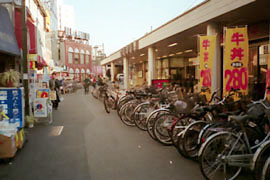 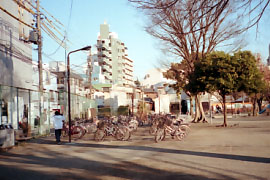
Around Shiinamachi station of Seibu Ikebukuro iine (2002.2.12)
The east side (for Ikebukuro) of north entrance of the station is no bicycle parking, but many bicycles are need to be parked. At the south side of the station bicycles are parked in the park.
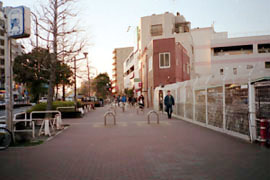
Around Senkawa station (2002.2.12)
There are wide pavements which have things constructed as bicycle parking. But Toshima city authority bans park here, constructed bicycle parkings which need fee nearby here.
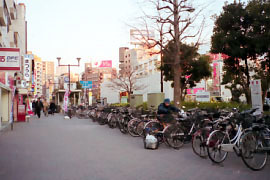 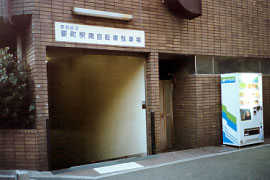
Around Kanamecho station (2002.2.12)
Bicycles are excluded from the parking space on the pavement, bisides nearby Senkawa. There is a bicycle parking underground of the building a pretty distant from the station. It has an entrance on the narrow road and unable to be seen from outside. It is a feature in Toshima City that the attitude of the management employee to the bicycle and the user in such a style bicycle parkings managed by Toshima city authority is so bad. It is dangerous for women at night.
Are These Really Cultural Institutions?
There are few problems about buildings of public institutes in Toshima City. But the plans of construction and the way of management and maintain is accomplished Toshima City Authority's policy. It is no better than that in cultural institutes like library their dignity and value are reduced, and in educational institutes children are taught to treat roughly and hate to bicycle.
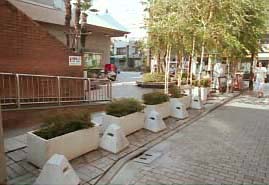 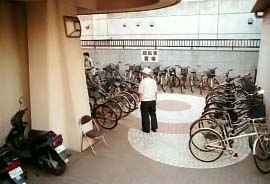
Central Library of Toshima city (2000.9.9)
This is a central core unifying other libraries. Its attitude to bicycle is no good. It stands along with the street, and designated to parking space aside of between street and steps to entrance. It has other parking under the steps which is inconvenient and unable to be seen and difficult to keep safe. Some employee threw dust, snow and water to bicycles parked here. At last enforcing to use the latter they broke the former with planters (left pic). Recently an old man who is neither a policeman nor a guardian stations at the latter. So it also choice the way to cost much more expensive. How many books the money could buy? How the money would make service by librarians better?
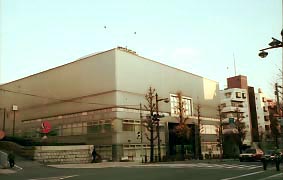 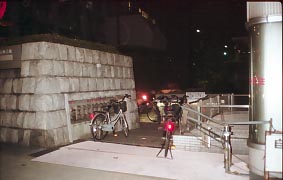
Chitose-bashi Centre of Education & Culture (2000.12.9-12)
It was established in the bubble economy period. Not only construction management and maintenance of it are bubbly -- without proper policy. Bicycle parking is aside of main entrance facing to street, and it hides bicycles from the view on the street and urban landscape. So few people parks their bicycles in it positively because of its smallness and lack of safeties. And many people park in front of it. But some guardians force to park there with threatening tone, sometimes replace bicycles into aside, and force to park even in front of fireplug. Their cruelty makes contradiction with keeping safety as original task.
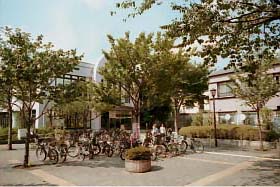
Kita-Ikebukuro Library & park of Toshima city (2000.9.9)
It is the newest public library in Toshima City and inside the park. Bicycles are gathered in the midst of passage from the road to entrance. This curiosity made by dwellers next to the park. It is proper to say that hatred policy to bicycles by Toshima City Authority effects dweller's thought.
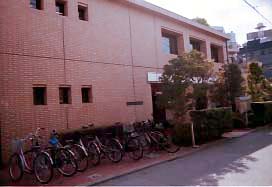
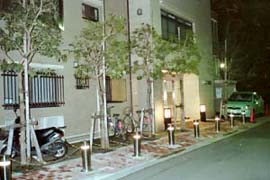
Mejirodai Library of Bunkyo city (2000.9.9), "Kotobuki" House of Toshima City (2002.2.6)
Bunkyo City is in the east of Toshima City. I will
submit to you an example for reference. Most of public institutes in Bunkyo City have bicycle parking at the place face to and along with the street and where are able to be seen from both inside and outside of the institutions. Besides it is easy to park, safe to bicycles because of eyes. It costs a minimum cost for Authority to construct and maintain. It seems there are no special policy on it, but it makes maximum effect. Needless to say there are no hatred policy to bicycles in contrast with Toshima City. "Kotobuki" House is one of the few public institution buildings that have such a bicycle parking in Toshima City. And it is next to Bukyo City.
Please reference with "An Example in Bunkyo City".
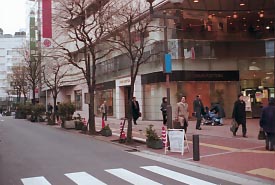 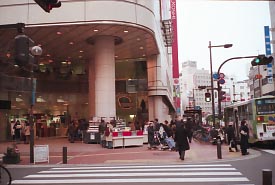
Ikebukuro Mitsukoshi Dept. store,
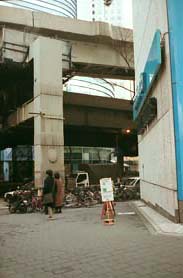 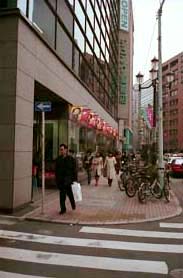 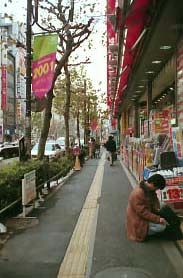
Tokyu-Hands Ikebukuro branch, Junku-do bookstore, BIC PC Store(2001.1.9)
Toshima City authority not only save themselves' face and keep constructional concession, reinforce hatred policy to bicycle. Under the name of direction to "construct bicycle parking", they really enforce large scale shops to cost for erasing bicycles from urban landscape. Bicycles parked in front of stores show many people come and buy here, also are advertisement towers
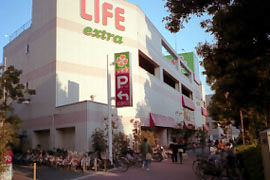 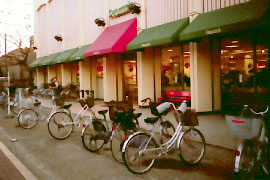
Supermarkets; Life Shiinamachi branch (left), Peacock Mejiro branch (right)(2002.2.12)
There are parking space in front of the stores easy for user. Life store puts the management of the bicycle parking to the elder workers centre of Toshima city. The attitude of the management employee is better than other bicycle parkings managed by the centre. But it is worse than other Life stores.
Please reference with "An Example in Itabashi City".
Why Does they so?
Raison d'être of "hochi-jitensha" to men of power is not only benefit and conscious. They utilize it as a chance to organize and unify people.
Attitude of Mass Media (2)
Not a few Japanese mass media reports bicycle affairs by the side of administrative authority and power, treat it as a problem of "hochi-jitensha", and campaigns anti-"hochi-jitensha". Their attitude is criminal not only to bicycle and rider but also Japanese people and Japanese democracy. Mass media's surrender and blind obedience to the power cannot be allowed!
Anti-"hochi-jitensha" campaign by Local Goverment Authority
The local government itself campaigns anti-"hochi-jitensha" most. Regardless of the difference of the degrees, it possible to say that Toshima City authority is one of the worst ones in the whole country. Sometimes anti-"hochi-jitensha" campaign is done through the City authority's public newspapers and the oppressing people. The campaign itself is done in the other cities or towns, but that the hatred view consciousness to the bicycle is prominent here. When attempting the prosecution, the city authority reaches to be an enemy to the people.
It sometimes calls "tekkyo" (removal) of -"hochi-jitensha" as "the clean fight". Needless to say it is unreasonable to handle the bicycle being there which exists with a purpose of each user, but it is necessary to say that it is unreasonable to say the exclusion like cleaning garbage. Moreover, don't forget we are forced to have the sense that where the one was excluded as "beautiful".
This is unreasonable interference in the individual mind and thought by the power and is the infringement of the liberty of the thought. To take on the management in the bicycle parking in addition to "tekkyo" (removal) of "hochi-jitensha" is the work of the aged people. Because they spent their childhood at the time when Japan reached fascism and imperialism and got education, they act as the advance guard in addition to being blind to such a problem. Their hatred and contempt consciousness to Asian people is so that they think and treat Asian people such as criminal or to be discriminated. This is the biggest discriminating against ethnicity or race of the people. At Toshima City where about 10 percent of the population are accounted for by the foreigner in Asia, this is the problem which can not be overlooked.
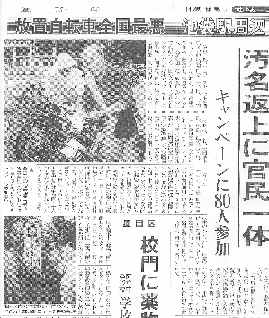
An example of anti-"hochi-jitensha" campaign
reported by major newspaper ("Yomiuri-shimbun" 2000.8.23)
The campaign is also reported by local newspaper "Toshima-shimbun" (2000.8.29)
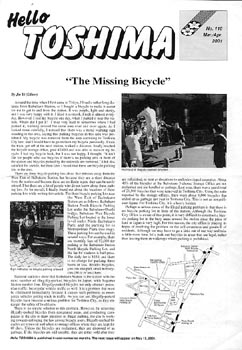
An example of anti-"hochi-jitensha" campaign by the City authority's public paper (2001.3)
The City authority have made a Chinese woman write which received its aim. When seeing the smiling face of her who doesn't understand to be the opponent of the bicycle user, in addition to weirdly, we feel ill and fear.
(Dec.15.2000. Added Mar.16, Jul.9.2001, Feb.8 &14 2002)
 
|

